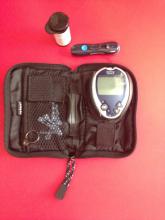Self-monitoring of blood glucose in patients with non–insulin-treated type 2 diabetes mellitus (T2DM) does not appear to make any difference to blood glucose control or quality of life, a new study has found.
The researchers report the results of the Monitor Trial in which 418 patients with non–insulin-treated T2DM were randomized either to once-daily self-monitoring of blood glucose with automatic tailored messages, once-daily monitoring with no messages, and no monitoring. Their report appears in the June 10 online edition of JAMA Internal Medicine, timed to appear simultaneously with the data’s presentation at the annual meeting of the American Diabetes Association
After 1 year, there were no significant differences in hemoglobin A1c levels or health-related quality of life measures – either physical or mental – between the three groups (JAMA Intern Med. 2017 Jun 10. doi: 10.1001/jamainternmed.2017.1233).
Researchers also saw no significant differences in rates of insulin initiation, the incidence of hypoglycemia, or health care utilization.
“This null result occurred despite training participants and primary care clinicians on the use and interpretation of the meter results,” wrote Laura A. Young, MD, of the University of North Carolina at Chapel Hill.
While the findings reflect data from earlier studies suggesting limited usefulness of self-monitoring of blood glucose in these patients, the authors commented that self-monitoring has persisted as a cornerstone of clinical management of non–insulin-treated T2DM.
“As the first large pragmatic U.S. trial of SMBG [self-monitoring of blood glucose], our findings provide evidence to guide patients and clinicians making important clinical decisions about routine blood glucose monitoring,” they wrote. “Based on these findings, patients and clinicians should engage in dialogue regarding SMBG with the current evidence suggesting that SMBG should not be routine for most patients with non– insulin-treated T2DM.”
The main difference seen between the three groups was in the Summary of Diabetes Self-Care Activities, which the authors said reflected the intervention itself.
Patients taking a GLP-1 agonist at baseline were significantly more likely to increase their dose of the drug if they were in one of the self-monitoring groups, compared with the no-monitoring group, but the authors noted that the numbers were small.
Researchers also saw that African Americans in the self-monitoring with messaging group had significantly lower health-related quality of life scores, compared with the no-monitoring group, although this difference was not seen with the self-monitoring without messaging.
The participants in the trial, which was conducted at 15 primary care practices in central North Carolina, were all older than 30 years and had HbA1c levels between 6.5% and 9.5% in the 6 months before screening.
Compliance rates were similar between the two self-monitoring groups and declined at a similar rate.
The authors cautioned that their study was not powered to examine the effectiveness of self-monitoring versus no monitoring in certain clinical situations, such as the initiation of a new medication or a change in medication dose.
“Proponents of routine SMBG have cited evidence that this testing approach is useful for patients with newly diagnosed diabetes or patients with poorer glycemic control,” they said.” Although disease duration, experience using SMBG, baseline glycemic control, antihyperglycemic treatment, age, race, health literacy, and number of comorbidities made no discernible difference in glycemic control at 52 weeks, absence of evidence is not evidence of absence.”
They also commented on the potential influence of more tailored interventions such as the messaging, saying that while earlier smaller studies had suggested this could be of benefit, this was not shown in their study.
The study was supported by a Patient-Centered Outcomes Research Institute Award and the National Center for Advancing Translational Sciences, National Institutes of Health. Two authors declared grants and nonfinancial support from a range of pharmaceutical companies, and the University of North Carolina licensed its interest in copyright works to Telcare for a glucose messaging and treatment algorithm for the purposes of commercialization.


